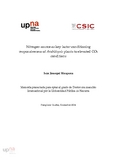Mostrar el registro sencillo del ítem
Nitrogen source as key factor conditioning responsiveness of Arabidopsis plants to elevated CO2 conditions
| dc.contributor.advisor | Aparicio Tejo, Pedro María | es_ES |
| dc.contributor.advisor | Aranjuelo Michelena, Iker | es_ES |
| dc.creator | Jáuregui Mosquera, Iván | es_ES |
| dc.date.accessioned | 2016-06-09T08:36:57Z | |
| dc.date.available | 2019-12-15T00:00:08Z | |
| dc.date.issued | 2014 | |
| dc.date.submitted | 2014-12-15 | |
| dc.identifier.uri | https://hdl.handle.net/2454/20870 | |
| dc.description.abstract | The amount of carbon dioxide (CO2) in Earth's atmosphere has exceeded 400 parts per million (ppm) during three continuous months of observations in 2014, which is an absolute record for the last 800,000 years. As a consequence, plants, as photosynthetic organisms, will inevitably be influenced by the changed growing conditions that result from the increased [CO2]. The effect of increased [CO2] on plants has been widely studied and goes far beyond favouring carboxylation of Rubisco and generating higher growth rates. The present thesis aims to highlight the relevance of different nitrogen sources in the response of Arabidopsis thaliana, a C3 model plant, to elevated [CO2]. For this purpose, this has been an integrated study of leaf and root organs combining techniques that range from plant physiology to molecular biology. Under nitrate nutrition and elevated [CO2] conditions, Arabidopsis thaliana plants increase their biomass and maximum photosynthetic rates; nevertheless, the total soluble protein, Rubisco content and leaf N content reveal a general decrease in leaf N availability (chapter I). Although the expression of nitrate transporters was substantially upregulated in roots, plants did not efficiently transport nitrate and other minerals from roots to leaves, which compromised leaf N and mineral status. Therefore, our results suggest that the diminution of transpiration rates causes a reduction in the xylem flux, which inexorably generates an imbalance in the transport of nitrate and mineral elements between organs under elevated [CO2]. Moreover, root nitrate assimilation (based on the amino acid content) is favoured in order to overcome N limitations due to the reduction in leaf nitrate assimilation. In chapter II plant performance under elevated [CO2] and ammonium nitrate conditions was characterized and it was found that biomass doubled due to substantially increased photosynthetic rates. Gas exchange characterization revealed that these plants overcame photosynthetic acclimation. Plants maintained Rubisco concentrations at control levels alongside enhanced energy efficiency. The increments found in leaf carbohydrates and organic acid content linked to enhanced respiration rates supported the fact that the plants under elevated [CO2] maintained their energy status. The transcriptomic analysis enabled the identification of photoassimilate allocation and remobilization as fundamental processes used by the plants to avoid photosynthetic acclimatization. Moreover, based on the relationship between plant carbon status and hormone functioning, the transcriptomic analyses provided an explanation of why phenology accelerates under elevated [CO2]. Finally, in chapter III the relevance of ammonium nutrition under elevated [CO2] was analysed; for this purpose a double nitrate reductase mutant (NR mutant, nia1-1/chl3-5 defective) was used. These results highlight that plants under elevated [CO2] which preferentially assimilate ammonium as their only N source maintain leaf growth and photosynthetic rates similar to plants receiving ammonium nitrate. However, under ambient [CO2] concentrations, ammonium toxicity symptoms emerge and development is extremely constrained. In elevated [CO2] conditions, an NR mutant maintained the energy supply for the Calvin cycle pathway and managed efficient photoassimilate transport between plant tissues. Furthermore, the data suggest active ammonium assimilation in leaves due to the exceptional conditions (C skeletons, ATP, adequate pH homeostasis and no photoinhibition) of these plants under elevated [CO2]. Hence, the results obtained in the present doctoral thesis aim towards the incorporation of the source of nitrogen as key in the response at the elevated [CO2] of Arabidopsis thaliana plants. Consequently, the present doctoral thesis aims to determine whether the incorporation of the correct source of nitrogen is the key component in how Arabidopsis thaliana plants respond to elevated [CO2]. | en |
| dc.description.sponsorship | This work was funded by the project: AGL2009-13339-C02-02 and AGL2012-37815-C05-5 | en |
| dc.format.extent | 129 p. | |
| dc.format.mimetype | application/pdf | en |
| dc.language.iso | eng | en |
| dc.subject | Nitrogen source | en |
| dc.subject | Arabidopsis plants | en |
| dc.subject | Carbon dioxide | en |
| dc.subject | CO2 | en |
| dc.title | Nitrogen source as key factor conditioning responsiveness of Arabidopsis plants to elevated CO2 conditions | en |
| dc.type | Tesis doctoral / Doktoretza tesia | es |
| dc.type | info:eu-repo/semantics/doctoralThesis | en |
| dc.contributor.department | Ciencias del Medio Natural | es_ES |
| dc.contributor.department | Natura Ingurunearen Zientziak | eu |
| dc.rights.accessRights | Acceso abierto / Sarbide irekia | es |
| dc.rights.accessRights | info:eu-repo/semantics/openAccess | en |
| dc.embargo.terms | 2019-12-15 | es_ES |
| dc.relation.projectID | info:eu-repo/grantAgreement/MICINN//AGL2009-13339-C02-02/ES/ | en |
| dc.relation.projectID | info:eu-repo/grantAgreement/MINECO//AGL2012-37815-C05-05/ES/ | en |
| dc.description.doctorateProgram | Programa Oficial de Doctorado en Agrobiología Ambiental (RD 1393/2007) | es_ES |
| dc.description.doctorateProgram | Ingurumen Agrobiologiako Doktoretza Programa Ofiziala (ED 1393/2007) | eu |


